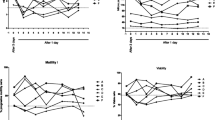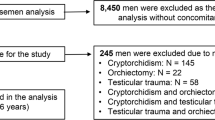Abstract
In this study, we sought to evaluate the effect of uremia on semen quality and reproductive function in humans. For this purpose, 53 end-stage uremic patients were randomly selected. The semen samples were produced by masturbation. Fertility index (FI) was calculated according to the following formula: sperm density (×106/ml) × sperm motility (%) × normal sperm morphology rate (% per 10,000). The semen samples of uremic patients were compared with those of fertile and infertile males. The results show that three patients failed to produce semen. There were no sperm found in four semen samples. The sperm motility, survival rate, sperm density, and normal sperm morphology rate of the remaining 46 patients were found to be significantly lower than those of controls. The uremic patients had the FI of 0.68(2.08) which was obviously lower than that of fertile 7.7(13.51) and infertile 4.13(5.77) males. It was, therefore, concluded that uremia caused a significant decline in sperm quality and reproductive function which resulted in consequential infertility in humans.
Similar content being viewed by others
References
Thomas, G., & Jaber, B. L. (2009). Convective therapies for removal of middle molecular weight uremic toxins in end-stage renal disease: A review of the evidence. Seminars in Dialysis, 22, 610–614.
Harvey, C. A. (1953). Fertility index derived from semen analysis. Journal of Clinical Pathology, 6, 232–236.
Xu, H. M., Wu, Y., Yang, L. H., Xu, L. G., & Zhang, J. R. (2007). Comparison of fertility index between fertile and infertile male. Reproduction and Contraception, 27, 618–620.
Diemer, T., & Desjardins, C. (1995). Developmental and genetic disorders in spermatogenesis. Human Reproduction Update, 5, 120–140.
Hales, D. B., Diemer, T., & Hales, K. H. (1999). Role of cytokines in testicular function. Endocrine, 10, 201–217.
Shiraishi, K., & Naito, K. (2007). Effects of 4-hydroxy-2-nonenal, a marker of oxidative stress on spermatogenesis and expression of p53 protein in male infertility. Journal of Urology, 178, 1012–1017.
Lessan-Pezeshki, M., & Ghazizadeh, S. (2008). Sexual and reproductive function in end-stage renal disease and effect of kidney transplantation. Asian Journal of Andrology, 10, 441–446.
Eldar, I., Godin, M., Bdolah, Y., Hurwitz, A., & Haimov-Kochman, R. (2008). Acute renal failure may lead to reversible azoospermia. Fertility and Sterility, 90, 11–12.
Koyun, M., Baysal, Y. E., Usta, M. F., Akman, S., & Güven, A. G. (2009). Evaluation of reproductive functions in male adolescents following renal transplantation. Pediatric Transplantation, 13, 697–700.
Xu, L. G., Shi, S. F., Qi, X. P., Huang, X. F., Xu, H. M., et al. (2005). Morphological characteristics of spermatozoa before and after renal transplantation. Asian Journal of Andrology, 7, 81–85.
Prem, A. R., Punekar, S. V., Kalpana, M., Kelkar, A. R., & Acharya, V. N. (1996). Male reproductive function in uraemia: efficacy of haemodialysis and renal transplantation. British Journal of Urology, 78, 635–638.
De Celis, R., & Pedron-Nuevo, N. (1999). Male fertility of kidney transplant patients with one to ten years of evolution using a conventional immunosuppressive regimen. Archives of Andrology, 42, 9–20.
Holdsworth, S. R., & Kretser, D. M. (1978). A comparison of hemodialysis and transplantation in reversing the uremic disturbance of male reproductive function. Clinical Nephrology, 10, 146–150.
Acknowledgments
We thank the Zhejian Province Medical Science (Grant #2009A182) and the Hongzhou Technology Division Science (Grant #20090833B22) organizations for their providing the financial support.
Author information
Authors and Affiliations
Corresponding authors
Additional information
Longgen Xu and Huiming Xu are co-first authors of this study.
Rights and permissions
About this article
Cite this article
Xu, L., Xu, H., Zhu, X. et al. Effect of Uremia on Semen Quality and Reproductive Function in Humans. Cell Biochem Biophys 62, 29–33 (2012). https://doi.org/10.1007/s12013-011-9254-9
Published:
Issue Date:
DOI: https://doi.org/10.1007/s12013-011-9254-9




